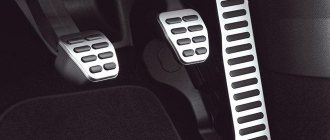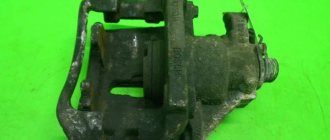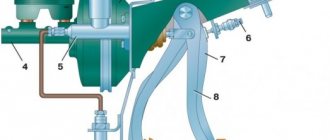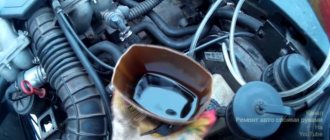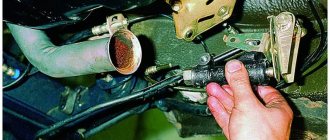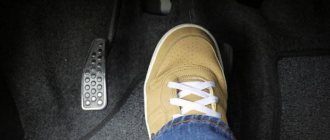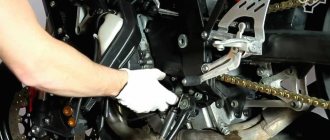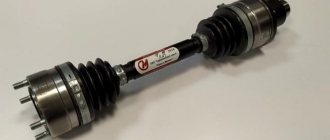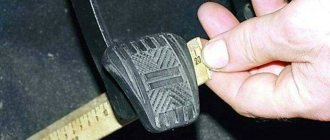In the article:
- The pedal has become too hard
- How to make sure the vacuum booster is working properly
- The brake pedal is too soft
- Results
The braking system is the most important component of any vehicle.
Automotive designers pay special attention to brakes, realizing that safety on the road and people’s lives depend on their impeccable operation. The brakes of modern cars are quite reliable, however, you need to remember that any parts during operation are subject to mechanical, thermal, chemical and other types of loads, and therefore wear out and may fail. Brake system parts are no exception, only in this case the cost of a malfunction can be very high. Certain signs that appear during braking can warn that something is wrong with the brakes - extraneous sounds or strong vibrations, the car pulling to the side, uneven or noticeably decreased braking efficiency and an increased braking distance. But the first thing people usually pay attention to is the behavior of the brake pedal. It can become too tight, so that you have to press on it with force, or, on the contrary, it can suddenly turn out to be too soft, or even fail completely. All this complicates braking and can lead to serious consequences. Let's talk in more detail about what causes such symptoms and what to do in such situations.
Correct diagnosis of car brakes
The correct pressing position for the leg can be analyzed from different angles. But the result will always be the same. In an effective and workable concept, the pressing force always remains the same; there are no exceptions in this case.
- What needs to be understood here is that sounds that are unusual for the car are also considered an indicator of failure.
- They appear during automatic influence on the engine; in this case, the pressing will remain unchanged.
- In such cases, you need to contact professionals or carry out independent restoration.
The pedal has become too hard
Sometimes a relatively tight brake pedal can be a feature of some car models. This nuance needs to be clarified if you have just purchased a car or are testing it before purchasing.
If everything was fine, but at some point you noticed that the pedal suddenly became “wooden” and you had to press on it with considerable force, then most likely the malfunction is related to the vacuum brake booster. It is this device that is designed to reduce the physical effort required to perform braking.
The ease of pressing the pedal occurs due to the difference in pressure in the atmospheric and vacuum chambers of the amplifier. Between the chambers there is a diaphragm with a rod that pushes the piston of the main brake cylinder (MBC), which, in turn, pumps brake fluid into the system lines and further to the working brake mechanisms. The vacuum in the vacuum chamber is created by an electric pump, and in gasoline engines the source of vacuum is often the intake manifold.
In the initial state, the cameras are connected to one another. When the pedal is pressed, the vacuum chamber is connected to the source of vacuum through a check valve, and the atmospheric chamber is connected to the atmosphere through an air valve. As a result, the diaphragm with the rod is drawn into the vacuum chamber. This reduces the force required to press on the GTZ piston. The vacuum amplifier can be made as a separate element or form a single module with the GTZ.
The most vulnerable element here is the rubber hose connecting the intake manifold to the vacuum chamber. Therefore, first of all, you should check its integrity and, if necessary, replace it.
Violation of tightness may be accompanied by non-standard behavior of the engine during braking - tripping, increasing or decreasing speed, sometimes fuel consumption increases. This is due to air leakage through a damaged hose and the entry of a lean mixture into the engine cylinders.
If the vacuum pump creates a vacuum, you need to check its serviceability.
In the vacuum booster itself, the air filter may become clogged, the diaphragm may be damaged, or one of the valves may lose mobility.
If necessary, you can purchase a new vacuum brake booster or try to repair the existing one. Be careful when disassembling - there is a spring inside, as well as a number of parts that can be easily lost. It must be borne in mind that during reassembly after repair it is not always possible to sufficiently ensure tightness, and therefore normal operation of the device.
When replacing the vacuum booster, it is not necessary to disassemble the turbocharger, and therefore there is no need to bleed the brake system.
The brakes can also become hard due to damage to the cuffs in the turbocharger or working cylinders and, as a result, a tighter stroke of the pistons in them. Treatment is to replace damaged parts or the cylinders themselves.
What to do if the brake pedal becomes hard
If the pedal becomes hard, it is necessary to determine the cause and eliminate it. A dirty air filter must be cleaned, and faulty limit switches, valves and hoses must be replaced. Usually this is enough for the system to work. If during diagnostics it turns out that the diaphragm is damaged, the entire amplifier will have to be replaced.
If the problem lies in the brake cylinders, they are repaired, including replacing seals and cuffs. In some cases, old parts are removed and new ones are installed in their place.
Is it possible to do something right away?
The best thing to do if you suspect a vacuum booster is broken or its elements are worn out is to go to the nearest car service center or replace the damaged parts yourself.
If there is an assumption that poor-quality brake fluid is to blame, it needs to be replaced. In this case, it is necessary to completely pump out the old one, and pour in a new one in its place. Otherwise, the situation will improve only slightly.
Other
To regularly check the brake fluid, it is better to buy an electronic tester that measures the boiling point. If it exceeds +175°C, it means the fluid has recently been changed. If it varies from +165 to +175°C, the properties have deteriorated, but it can still be used. The fluid needs to be changed if it was filled more than 2 years ago or its boiling point has dropped below +165°C.
Video: Replacing brake fluid
How to make sure the vacuum booster is working properly
First you should do a visual check. Make sure there are no brake fluid leaks and the booster housing is not damaged. Check the integrity of the hoses and the tightness of their connections to the fittings. If necessary, tighten the clamps.
A hissing sound that occurs when you press the brake pedal may indicate a leak. This hissing often persists for some time after the engine is turned off and then it can be heard quite clearly.
There are several ways to check the performance of the vacuum booster.
- The engine must be stopped. Press the brake pedal 6-7 times in a row to equalize the pressure in the booster chambers, and then squeeze the brake all the way and start the engine in this position. If the amplifier is working properly, a vacuum will appear in the system. Due to the pressure of the diaphragm, the rod will move, pulling the pusher along with it. And since the pusher is mechanically connected to the pedal, it will lower slightly, and this can easily be felt with your foot. If this does not happen, it means that a vacuum has not arisen in the system. If you have any doubts, try the second method.
- Turn on the engine, let it idle for a few minutes, then turn it off. Press the brake fully two or three times and release the pedal. If the vacuum booster is working normally and there is no air suction, then the first one or two presses will be soft, and the subsequent ones will be noticeably tighter. If you don't notice any difference in the pedal travel, then there is a problem with the amplifier.
- With the engine running, depress the brake pedal and, while holding it down, turn off the engine. If you now remove your foot from the pedal, it should remain in the lowered state for some time, thanks to the remaining vacuum in the vacuum chamber of the amplifier.
Methods for diagnosing brakes at home
It is necessary to start the energy-power device, this will create a vacuum in the braking concept. Then you need to press on the accelerator. If it is still hard, then the amplifier or tube is damaged.
When turning off the engine and without pressing the brake, you must wait 4 to 6 minutes. After the period has expired, press the accelerator. If the lever has not lost its hardness, most likely the VU hydraulic valve is not working.
When the engine is not running, you need to depress the accelerator several times. These influences will remove the release of the inhibitory concept. Next, hold the accelerator to its limit and start the engine.
If the accelerator decreases, this will mean that there are no questions about the VU. The latter method makes it possible to extremely effectively monitor the functionality of the amplifier.
- Depressurization is very easy to recognize. An indicator of this malfunction is the inconsistent activity of the motor, as they say, it “troubles.”
- The factor behind this problem depends on air entering the intake duct.
- During depressurization, the air-fuel composition rapidly becomes depleted.
- If the accelerator is not pressed in any way while the car is running, you first need to check the connection reliability.
- An indicator of this malfunction is also considered to be a distinctive hissing sound from the cryogenic amplifier on a functioning motor.
The information described above can help if you have any difficulties with the “hardening” of the brake pedal. If any change is detected, it is necessary to urgently begin restoration and eliminate the malfunction as quickly as possible.
The brake pedal is too soft
If pressing the pedal has become too soft, it means there are air bubbles in the hydraulics and then the system should be pumped, or there is a loss of working fluid. The first thing you need to do is check the brake fluid level. If it is below the permissible level, the hydraulic system must be carefully checked for leaks. A leak may occur at the connection points between the tubes and fittings due to poorly clamped clamps, and the hoses themselves may be damaged. Working fluid can also be lost in wheel brake cylinders if the seals are damaged. After eliminating the leak, you will also need to bleed the brake system hydraulics to remove air from it.
If the brake fluid is of poor quality, contaminated, or has not been changed for a long time and has lost its properties, then heating during sudden braking can quite easily lead to its boiling, and then the brakes will become “wobbly” and the car itself will be difficult to control. An old, dirty, or inadequate brake fluid can cause seized brake cylinders, damaged seals, and other problems. The conclusion is obvious - pay attention to the condition of the brake fluid and change it in a timely manner.
Another reason for a soft brake pedal is the hoses, which are made of rubber and wear out over time, becoming loose. When hydraulic pressure builds up during braking, they simply inflate. As a result, the brakes become too soft and braking becomes less effective.
An extreme and very dangerous manifestation of soft brakes is pedal failure. This occurs due to significant leakage of fuel fluid or damage to the sealing rings in the gas turbine engine.
An excessively soft brake pedal, and even more so if it fails, requires an urgent solution to the problem. You need to stop immediately, braking with the engine or handbrake, and then find and correct the problems.
Braking system design
First, let's refresh our memory on the schematic diagram of this mechanism.
- Directly below the driver's seat there is a row of pedals. One of them, usually the far left, is responsible for the brake.
- Several levers extend from it, at the other end of which there is a vacuum booster. For its work, it takes air from the engine.
- The force obtained from the interaction of the two above elements is distributed between the wheels by the master brake cylinder. At this stage, the brake fluid is already involved.
- The substance is transported by metal tubes and rubber hoses.
- Pressure is transferred to the gaskets and wheel cylinders of each of the four wheels, as well as the drum and parking brakes.
Results
Other problems with the brake system are also possible - wear or oiling of brake pads, discs and drums, jamming of wheel cylinders and caliper guides. But one thing is clear - the braking system requires serious attention. Regular inspection, prevention and replacement of the vehicle, immediate response to problems and timely troubleshooting will allow you to feel more confident on the road and avoid many unpleasant and dangerous situations.
Use only high-quality spare parts, and in order not to run into fakes, purchase them from trustworthy stores.
Solving the problem of a soft pedal
So, the most common problem is poor, low-quality fluid, due to the fact that it may not be suitable for a certain car model, and corrosion of the hoses may gradually appear. Rubber elements are not able to withstand such liquid; they delaminate and increase in diameter, which leads to loss of tightness. If the brake pedal has become soft, it is best to undergo diagnostics of the entire brake system, replace the fluid and defective elements.
The second reason is rust in the rods. There is only one way out - replacing them completely. You can determine such a malfunction by holding down the brake pedal; if it remains down and you have to “lift” it with improvised tools, there is definitely a problem in the rods.
The incorrect gap between the pedal and the cylinder is also determined by the pedal being clamped. If pressing immediately occurs easily and smoothly, and at the end the applied force has to be doubled, most likely the gap is incorrectly adjusted; the pressure present does not allow the pedal to be lowered and raised normally. You will have to adjust and bleed the brakes.
Air locks also cause a lot of trouble, appearing due to wear and tear of the hoses; they lead to breakdowns in the vacuum pump. The brake cylinders lose some of the pressure, the pads do not move apart, and therefore cannot press against the disc. The pads should be checked for any wear.
Is it possible to add brake fluid from another manufacturer or brand to the reservoir?
Going to buy 1 liter of TJ – it would seem that there’s nothing special about it. I came to the store, ordered, paid and went to the garage with a satisfied look. This was the case before, when out of all the auto chemical enterprises there was only one in the news - the Dzerzhinsky plant. Now you can not only easily confuse diesel and gasoline oil, but also the composition of the braking system. After all, in the market, even experts sometimes get their eyes wide open. Here you have Rosdot, and Sintec, and a bunch of other similar names.
What will an unscrupulous driver do? He’ll take any one and go with the idea of quickly resolving the issue. Motorists are rushing to warn against such indifference. The mixing operation is, of course, permissible, and the manufacturer even indicates with what compounds his product can be used. The question is whether it is possible to add brake fluid of another brand when the consumer is not aware of the origin of the emulsion already filled.
Undoubtedly, the code for the current composition can be found in the instruction manual. What if it is lost, or the car is bought secondhand? In general, if the situation is unclear, it is recommended to completely change the working fluid. What you definitely shouldn’t do is pour in TF with a low boiling point. Dangerous.
#1 Gladiator
Our locomotive fly forward!
Good afternoon. Now that I have time, I want to work on the brakes.
There is a pressing problem - low braking (slowdown) efficiency and a soft brake pedal.
Those. There seem to be brakes, but for a critical situation they are clearly too weak - I may not have time to stop. Those. I press the pedal (at least to the floor) and it slows down slowly. There is not even any talk about use.
By analogy with a bicycle - there are those in which you press on the pedal and the rear wheel is blocked until the black stripe on the asphalt, and on the other - you press - but you won’t stop quickly, there is no effective deceleration (that’s how it is for me).
1. The brakes are bled. True, the sorcerer did not stick a screwdriver into it, but he loaded the trunk with 100 kg.
2. The front cylinders were sour. I treated it a little with castor oil. When driving without braking, they do not jam, the discs are cold. When driving around the city, they work. After the trip, the discs are warm (the front right and rear left are hotter than the front left and rear right). The rear right disc is the coldest. When braking, the car does not go anywhere. There is no vibration.
3. GTZ costs Pilenga. The vacuum rod was not adjusted. If you stand at a traffic light and keep your foot on the brake, the pedal does not go down, i.e. The GTZ doesn't seem to let it through.
4. When the car is not started, it is impossible to pump up the brake pedal. Previously, after several pumping motions, its stroke became less and less and the pedal became stuck. Now this is not the case. True, if you start the engine with the pedal pressed, it goes down a little. Well, when pumping up the pedal, it hisses a little - it wheezes. True, when running, the engine speed does not change when swinging.
5. The brake hoses are new (Lukas), the brake fluid is fresh, there are no leaks anywhere.
Reviews
Hard pedal - failure of the vacuum pump or vacuum booster or leaking vacuum hose. Or the master cylinder wedge.
https://www.bmwclub.ru/threads/propadajut-tormoza-tverdaja-pedal.896947/
I had the same problem, if I let someone drive my car, they complained that the brake pedal was hard. They were sent with the statement that normal, well, there is strength - the mind... As a result, during the next maintenance, it turned out that the CH was a little high (gasoline). When I started looking into it, it turned out that air was being sucked into the vacuum brake booster through a worn-out gasket. At high speeds there is sufficient vacuum, but at low speeds the pressure gradually drops. Replacing the gasket solved the problem...
https://audi-belarus.by/forum/viewtopic.php?t=44405
I also struggled with this pedal for a long time. I'll pump it up for a couple of days. Then again. The vacuum operator with the main brake also made a mistake. Then I replaced the pads at the rear and the problem disappeared.
https://www.drive2.ru/c/2425257/
In order for the brake pedal to work well, you need to regularly change the fluid, lubricate the caliper guides, and inspect the VUT elements for damage.
Source
Mono: how to change car brake fluid for one person without assistance
There is only one way to solve the question of how to replace brake fluid for one person. His goal is to update the composition in the tank and lines without using the help of a partner. The features of this method are similar to bleeding the brakes:
- To speed up the process, it is recommended to immediately remove the working emulsion from the expansion tank using a bulb or a syringe with a tube attached.
- The preparatory stage consists of purchasing 1 liter of brake fluid and a 1 meter long tube, suitable in diameter to the outlet fittings on the brake cylinders. You will also need a cut-off bottle with a certain amount of working fluid so that air does not pass through the fitting into the system.
- During the process of replacement/pumping, the composition gradually leaves the tank. The level must be replenished regularly, otherwise the system will become airy.
Process technology
The essence of the replacement is the flow of the working fluid under the influence of gravity. After all, the tank is at the highest point. In fact, the operation is no more difficult than checking the injectors of a diesel or gasoline engine. As a result, the set of actions is as follows:
- Empty the expansion tank and fill it with new fluid up to the MAX limit mark.
- Clean all 4 drain fittings and install tubes on them. Place the latter in plastic containers with “brake fluid”.
- Unscrew all the drain fitting nuts one by one:
- right rear;
- left rear;
- right front;
- left front.
- While watching how the composition drains, do not forget to add a new drug to the tank.
- When the volume of liquid poured from the left front wheel reaches approximately 200 ml, tighten the fittings on it and on all other cylinders in the reverse order:
- front left;
- front right;
- rear left;
- rear right.
- Restore the fluid level in the tank.
- Clean the fitting and put a tube on it, lowered into the brake fluid.
- Create pressure in the retarding system.
- Unscrew the union nut and wait until the liquid pressure decreases to low.
- Close the fitting.
- Repeat until liquid comes out without bubbles.
Leveling up
The method is relevant if there is no air in the deceleration system. If there are air bubbles in the unit, the emulsion will not drain under the influence of gravity. Excessive pressure is required to bleed it off - just like in production. In this case, replacing the composition comes down to bleeding the brakes:
Excessive pressure in the system can be created in several ways:
- Find an assistant or pump the brake pedal yourself and press it with a gas stop from the hood/trunk installed between it and the seat.
- Insert the syringe with the emulsion into the lid of the tank and seal it. Having opened the fitting, press the syringe pusher.
- Install the car nipple into the cover. Seal with sealant or superglue. Remove the nipple and install the tube. Install the opposite end of the hose onto the quick-release tip of the pump. Take excess pressure from the spare tire. You can do it even simpler - apply pressure from the compressor to the spool.
